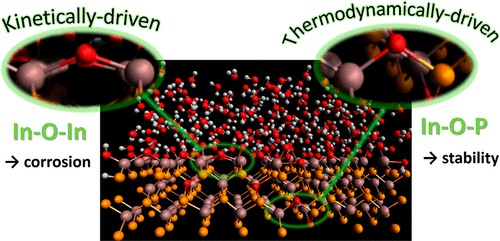当前位置:
X-MOL 学术
›
J. Phys. Chem. C
›
论文详情
Our official English website, www.x-mol.net, welcomes your
feedback! (Note: you will need to create a separate account there.)
Modulation of Surface Bonding Topology: Oxygen Bridges on OH-Terminated InP (001)
The Journal of Physical Chemistry C ( IF 3.3 ) Pub Date : 2020-01-23 , DOI: 10.1021/acs.jpcc.9b11548 Xueqiang Zhang 1, 2 , Tuan Anh Pham 3 , Tadashi Ogitsu 3 , Brandon C. Wood 3 , Sylwia Ptasinska 1, 4
The Journal of Physical Chemistry C ( IF 3.3 ) Pub Date : 2020-01-23 , DOI: 10.1021/acs.jpcc.9b11548 Xueqiang Zhang 1, 2 , Tuan Anh Pham 3 , Tadashi Ogitsu 3 , Brandon C. Wood 3 , Sylwia Ptasinska 1, 4
Affiliation

|
An understanding and control of complex physiochemical processes at the photoelectrode/electrolyte interface in photoelectrochemical cells (PECs) are essential for developing advanced solar-driven water-splitting technology. Here, we integrate ambient pressure X-ray photoelectron spectroscopy (APXPS) and high-level first-principles calculations to elucidate the evolution of the H2O/InP (001) interfacial chemistry under in situ and ambient conditions. In addition to molecular H2O, OH and H are the only two species found on InP (001) at room temperature. Under elevated temperatures, although the formation of In–O–P is thermodynamically more favorable over In–O–In, the latter can be preferentially generated in a kinetically driven and nonequilibrated environment such as ultrahigh vacuum (UHV); however, when InP is exposed to H2O at both elevated pressures and temperatures, its surface chemistry becomes thermodynamically driven and only In–O–P (or POx) oxygen bridges form. Our simulations suggest that In–O–In, rather than In–O–P, constitutes a charge carrier (hole) trap that causes photocorrosion in PEC devices. Therefore, understanding and modulating the chemical nature of oxygen bridges at the H2O/InP (001) interface will shed light on the fabrication of InP-based photoelectrodes with simultaneously enhanced stability and efficiency.
中文翻译:

表面键合拓扑的调制:OH端接的InP(001)上的氧桥
对光电化学电池(PEC)中光电极/电解质界面处复杂的物理化学过程的理解和控制,对于开发先进的太阳能驱动的水分解技术至关重要。在这里,我们集成了环境压力X射线光电子能谱(APXPS)和高级第一性原理计算,以阐明H 2 O / InP(001)界面化学在原位和环境条件下的演化。除了分子H 2O,OH和H是在室温下在InP(001)上发现的仅有的两种物质。在高温下,尽管In–O–P的形成在热力学上优于In–O–In,但后者可以优先在动力学驱动且非平衡的环境(例如超高真空(UHV))中生成。但是,当InP在升高的压力和温度下暴露于H 2 O时,其表面化学性质将由热力学驱动,并且仅形成In–O–P(或PO x)氧桥。我们的模拟表明,In-O-In而不是In-O-P构成了一个电荷载流子(空穴)陷阱,导致PEC器件发生光腐蚀。因此,了解和调节H 2处氧桥的化学性质O / InP(001)界面将为基于InP的光电极的制造提供启示,同时提高稳定性和效率。
更新日期:2020-01-23
中文翻译:

表面键合拓扑的调制:OH端接的InP(001)上的氧桥
对光电化学电池(PEC)中光电极/电解质界面处复杂的物理化学过程的理解和控制,对于开发先进的太阳能驱动的水分解技术至关重要。在这里,我们集成了环境压力X射线光电子能谱(APXPS)和高级第一性原理计算,以阐明H 2 O / InP(001)界面化学在原位和环境条件下的演化。除了分子H 2O,OH和H是在室温下在InP(001)上发现的仅有的两种物质。在高温下,尽管In–O–P的形成在热力学上优于In–O–In,但后者可以优先在动力学驱动且非平衡的环境(例如超高真空(UHV))中生成。但是,当InP在升高的压力和温度下暴露于H 2 O时,其表面化学性质将由热力学驱动,并且仅形成In–O–P(或PO x)氧桥。我们的模拟表明,In-O-In而不是In-O-P构成了一个电荷载流子(空穴)陷阱,导致PEC器件发生光腐蚀。因此,了解和调节H 2处氧桥的化学性质O / InP(001)界面将为基于InP的光电极的制造提供启示,同时提高稳定性和效率。











































 京公网安备 11010802027423号
京公网安备 11010802027423号